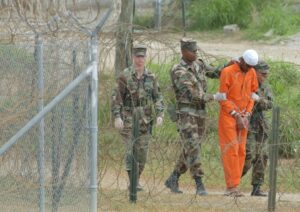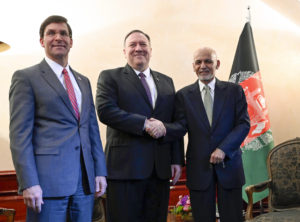Question for Gina Haspel: Does Torture Rig the Case for War?
The confirmation hearing for the CIA director nominee offers a chance to show how the U.S. government manufactures consent through insidious means. Gina Haspel, nominee for CIA director, center. (Pablo Martinez Monsivais / AP)
Gina Haspel, nominee for CIA director, center. (Pablo Martinez Monsivais / AP)
With the nomination of Gina Haspel to be director of the CIA, there’s rightfully some interest in her record regarding torture.
Of course, there are questions of legality and ethics with respect to torture, and it’s possible, as some have argued, that the motivation of Haspel and others in overseeing torture and covering it up may be simple sadism.
But—especially given how little we know about Haspel’s record—it’s possible that there’s an even more insidious motive in the U.S. government practicing torture: to produce the rigged case for more war. Examining this possibility is made all the more urgent as Donald Trump has put in place what clearly appears to be a war cabinet. My recent questioning at the State Department failed to produce a condemnation of waterboarding by spokesperson Heather Nauert.
Gina Haspel’s hearing on Wednesday gives increased urgency to highlighting her record on torture and how torture has been “exploited.” That is, how torture was used to create “intelligence” for select policies, including the initiation of war.
Lawrence Wilkerson, former chief of staff to Colin Powell, has stated that neither he nor Powell were aware that the claims that Powell made before the United Nations just before the invasion of Iraq where partly based on torture. According to Wilkerson, Dick Cheney and the CIA prevailed on Powell to make false statements about a connection between al-Qaida and Iraq without telling him the “evidence” they were feeding him was based on tortured evidence. See my piece and questioning of Powell: “Colin Powell Showed that Torture DOES Work.”
The 2014 Senate torture report noted (in an obscure footnote) the case Wilkerson speaks of: Ibn Shaykh al-Libi stated while in Egyptian custody and clearly being tortured that “Iraq was supporting al-Qa’ida and providing assistance with chemical and biological weapons. Some of this information was cited by Secretary Powell in his speech at the United Nations, and was used as a justification for the 2003 invasion of Iraq. Ibn Shaykh al-Libi recanted the claim after he was rendered to CIA custody on February [censored], 2003, claiming that he had been tortured by the [censored, likely ‘Egyptians’], and only told them what he assessed they wanted to hear.” (Libi would in due course be turned over to Muammar Gaddafi during a brief period when he was something of a U.S. ally and be conveniently “suicided” in Libyan custody; see my piece “Torture Did Work—to Produce War (See Footnote 857).”)
The Senate Armed Services Committee in 2008 indicates the attempt to use torture to concoct “evidence” was even more widespread. It quoted Maj. Paul Burney, who worked as a psychiatrist at Guantanamo Bay prison: “A large part of the time we were focused on trying to establish a link between al-Qaeda and Iraq and we were not successful. The more frustrated people got in not being able to establish that link … there was more and more pressure to resort to measures that might produce more immediate results.” The GTMO Interrogation Control Element Chief, David Becker told the Armed Services Committee he was urged to use more aggressive techniques, being told at one point “the office of Deputy Secretary of Defense [Paul] Wolfowitz had called to express concerns about the insufficient intelligence production at GTMO.”
McClatchy reported in 2009 that Sen. Carl Levin, the chair of the Armed Services Committee, said: “I think it’s obvious that the administration was scrambling then to try to find a connection, a link (between al-Qaida and Iraq) … They made out links where they didn’t exist.”
Exploiting false information has been well understood within the government. Here’s a 2002 memo from the military’s Joint Personnel Recovery Agency to the Pentagon’s top lawyer—it debunks the “ticking time bomb” scenario and acknowledged how false information derived from torture can be useful:
“The requirement to obtain information from an uncooperative source as quickly as possible—in time to prevent, for example, an impending terrorist attack that could result in loss of life—has been forwarded as a compelling argument for the use of torture. … The error inherent in this line of thinking is the assumption that, through torture, the interrogator can extract reliable and accurate intelligence. History and a consideration of human behavior would appear to refute this assumption.”
The document (released by The Washington Post, which minimized its most critical revelations and was quickly forgotten in most quarters) concludes:
“The application of extreme physical and/or psychological duress (torture) has some serious operational deficits, most notably, the potential to result in unreliable information. This is not to say that the manipulation of the subject’s environment in an effort to dislocate their expectations and induce emotional responses is not effective. On the contrary, systematic manipulation of the subject’s environment is likely to result in a subject that can be exploited for intelligence information and other national strategic concerns.” (See PDF.)
So torture can result in the subject being “exploited” for various propaganda and strategic concerns.
The New York Times reported in a February 2017 article, “Gina Haspel, C.I.A. Deputy Director, Had Leading Role in Torture,” that “Mr. [Abu] Zubaydah alone was waterboarded 83 times in a single month, had his head repeatedly slammed into walls and endured other harsh methods before interrogators decided he had no useful information to provide. The sessions were videotaped and the recordings stored in a safe at the CIA station in Thailand until 2005, when they were ordered destroyed. By then, Ms. Haspel was serving at CIA headquarters, and it was her name that was on the cable carrying the destruction orders.”
Some have made an issue of videos of torture being destroyed—but it’s been widely assumed that they were destroyed simply because of the potentially graphic nature of the abuse or to hide the identity of those doing the torture. But there’s another distinct possibility: They were destroyed because of the questions they document being asked. Do the torturers ask: “Is there another terrorist attack?” Or do they compel: “Tell us that Iraq and al-Qaida are working together”? The video evidence to answer that question has apparently been destroyed by order of Haspel—with barely anyone raising the possibility of that being the reason.
Even beyond the legal and ethical concerns, the following questions are in order:
- Are you familiar with the case of Ibn Shaykh al-Libi? Do you acknowledge that he was tortured at the behest of the U.S. government by the Egyptian government to produce a false confession that Iraq was linked to al-Qaida and therefore a pretext for war, with Colin Powell presenting that information at the U.N.?
- Why were others similarly tortured in 2002 and 2003? Was it really to allegedly protect us, or was it to gain fabricated statements that could be used to rig the case for the Iraq invasion?
- Are you familiar with the practice of exploiting torture?
- Have you ever participated in in any way—or helped cover up—the exploitation of torture?
- Why did you order the destruction of the video tapes of the torture?
- What assurance do we have that you and others who were involved in this won’t do it all again?
- Why do you approve of and cover up for torture? Is it sadism or is it to achieve strategic purposes? What of the motives of your cohorts and superiors?
Sam Husseini is a senior analyst at the Institute for Public Accuracy.
Your support is crucial…With an uncertain future and a new administration casting doubt on press freedoms, the danger is clear: The truth is at risk.
Now is the time to give. Your tax-deductible support allows us to dig deeper, delivering fearless investigative reporting and analysis that exposes what’s really happening — without compromise.
Stand with our courageous journalists. Donate today to protect a free press, uphold democracy and unearth untold stories.









You need to be a supporter to comment.
There are currently no responses to this article.
Be the first to respond.